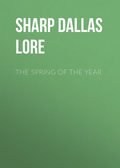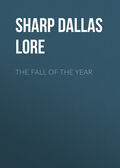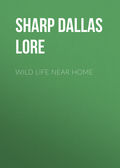
Sharp Dallas Lore
Summer
CHAPTER XII
THE “CONY”
We were threading our slow way along the narrow divide of the Wallowa Mountains that runs between the branches of the Snake River. Our guide was a former “camp-tender,” one who carries provisions to the sheep-herders in the mountains. As we were stopping a moment to breathe our horses and to look down upon the head springs of Big Sheep and Salt Lick Creeks on one side, and the narrow ribbon of the Imnaha on the other, this guide and our mammal-collector rode on ahead. An hour later I saw them round the breast of a peak far along on the trail and disappear. That night they brought into camp a “cony,” or pika, or little chief hare.
The year before, this camp-tender, in passing a certain rock-slide among the high peaks of the pass, had heard and seen a peculiar little animal about the size and shape of a small guinea-pig, whistling among the broken rock. He had never seen the little creature before, – had never heard of it. It was to this slide that he now took our naturalist, in the hope of showing him the mountain guinea-pig, and, sure enough, they brought one back with them, and showed me my first “cony,” one of the rarest of American mammals.
But I was broken-hearted. That I should have been so near and missed it! For we had descended to Aneroid Lake to camp that night, and there were no cony slides below us on the trail.
While the men were busy about camp the next morning, I slipped off alone on foot, and, following the trail, got back about ten o’clock to the rock-slide where they had killed the cony.
A wilder, barrener, more desolate land of crags and peaks I never beheld. Eternal silence seemed to wrap it round. The slide was of broken pieces of rock, just as if the bricks from an immense chimney had cracked off and rolled down into the valley of the roof. Stunted vegetation grew around, with scraggly wild grass and a few snow-line flowers, for this was on the snow-line, several melting banks glistening in the morning sun about me.
I crept round the sharp slope of the peak and down to the edge of the rock-slide. “Any living thing in that long heap of broken rock!” I said to myself incredulously. That barren, blasted pile of splintered peaks the home of an animal? Why, I was on the top of the world! A great dark hawk was wheeling over toward Eagle Cap Mountain in the distance; far below me flapped a band of ravens; and down, down, immeasurably far down, glistened the small winding waters of the Imnaha; while all about me were the peaks, lonely, solitary, mighty, terrible! Such bleakness and desolation!
But here, they told me, they had shot the cony. I could not believe it. Why should any animal live away up here on the roof of the world? For several feet each side of the steep, piled-up rock grew spears of thin, wiry grass about six inches high, and a few stunted flowers, – pussy’s-paws, alpine phlox, and beardtongue, all of them flat to the sand, – and farther down the sides of the ravine were low, twisted pines, – mere prostrate mats of trees that had crept in narrow ascending tongues, up and up, until they could hang on no longer to the bare alpine slopes. But here above the stunted pines, here in the slide rock, where only mosses and a few flat plants could live, – plants that blossom in the snow, – dwell the conies.
I sat down on the edge of the slide, feeling that I had had my labor for my pains. We had been climbing these peaks in the hope of seeing one of the last small bands of mountain sheep that made these fastnesses their home. But, much as I wished to see a wild mountain sheep among the crags, I wished more to see the little cony among the rocks. “As for the stork,” says the Bible, “the fir trees are her house. The high hills are a refuge for the wild goats; and the rocks for the conies.” I had always wondered about those conies – what they looked like and how they lived among the rocks.
I knew that these little conies here in the slide (if indeed they could be here) were not those of the mountain-peaks of Palestine. What of that! The very rocks might be different in kind from the rocks of Nebo or Lebanon; but peaks are peaks, and rocks are rocks, and the strange little “rabbits” that dwell in their broken slides are all conies to me. The cony of the Bible is the little hyrax, a relative of the elephant.
I sat for a while watching. Was this the place? I must make sure before I settled down to waiting, for when in all my life again might I have this chance?
Out in the middle of the slide was a pile of rocks with an uneven look about them, as if they had been heaped up there by other hands than those that hurled them from the peak. Going quietly out, I examined them closely, and found the perfect print of a little bloody paw on one of them.
This was the right place. Here was where they had shot the specimen brought into camp. I got back to my seat, ready now to wait, even while I knew that I was holding back the camp from its day’s march.
Perhaps I had been watching for half an hour, when from somewhere, in the rock-slide surely, though I could not tell, there sounded a shrill bleating whistle, not unlike the whistles of the ground squirrels and marmots that I had heard all through the mountains, yet more tremulous and not so piercing.
I waited. Presently a little gray form crept over a stone, stopped and whistled, then disappeared. It was my cony!
If you can think of Molly Cottontail turned into the shape of a guinea-pig about eight inches long, with positively no tail at all, and with big round broad ears, and with all four legs of equal length so that the creature walks instead of hopping, – if you can imagine such a rabbit, – you will get a pretty clear picture of the cony, or pika, or “little chief hare.”
I kept as still as the stones. Presently the plaintive, bleating whistle sounded from nowhere again – behind me, beyond me, up the slide or down, I could not tell. The rocks were rough, rusty chunks two or three feet long, piled helter-skelter without form or order, so that any one spot in the slide looked precisely like every other spot. I could not tell just the piece the cony had crossed, once my eyes were off of it, nor into which of the cracks he had disappeared. I could only sit still and wait till I caught him moving, so completely did his color blend with the rusty brown tone of the slide.
All the while the shrill, piteous call kept coming from anywhere in the slide. But it was not the call of several voices, not a colony whistling at once. The conies live in colonies, but, judging from the single small haycock which they had curing in the sun, I think there could not have been more than two or three pairs of them in this particular slide. Possibly there was only the single pair, one of which had been shot, for presently, when my eyes grew sharp enough to pick the little creature out against the rocks, I found that one was doing all the calling, and that for some reason he was greatly disturbed.
Now he would stop on a slab and whistle, then dive into some long passage under the stones, to reappear several feet or yards away. Here he would pause to listen, and, hearing nothing, would call again, waiting for an answer to his tremulous cry which did not come.
Under and over the stones, up and down the slide, now close to me, now on the extreme opposite edge of the pile he traveled, nervously, anxiously looking for something – for some one, I truly think; and my heart smote me when I thought it might be for the dead mate whose little bare foot-pads had left the bloody print upon the rock.
Up and down, in and out, he ran, calling, calling, calling, but getting no answer back. He was the only one that showed himself, the only live one I have ever seen, but this one I followed, as he went searching and crying over the steep rock-slide, with my eye and with the field-glasses, until long past noon – with a whole camp down the cañon looking for me!
But they must know where to look. Let them climb out of the cañon, back to the top of the world to the cony slide, if they could not wait for me.
Higher up than the mountain sheep or the goat can live, where only the burrowing pocket gopher and rare field mice are ever found, dwells the cony. This particular slide was on one of the minor peaks, – loftier ones towered all about, – nor do I know just how high it was, but the cony dwells above the tree-line, up in the Arctic-Alpine Zone, in a world of perpetual snow, from ten to fourteen thousand feet above the sea.
By perpetual snow I mean that the snow-banks never melt in the shadowed ravines and on the bare north slopes. Here, where I was watching, the rock-slide lay open to the sun, the scanty grass was green beyond the gully, and the squat alpine flowers were in bloom, the saxifrage and a solitary aster (April and September together!) blossoming in the edges of the snow just as fast as the melting banks allowed them to lift their heads. But any day the wind might come down from the north, keen and thick and white about the summits, and leave the flowers and the cony slide covered deep beneath a drift.
Spring, summer, and autumn are all one season, all crowded together – a kind of peak piercing for a few short weeks the long, bleak, unbroken land of winter here on the roof of the world.
But during this brief period the thin grass springs up, and the conies cut and cure it, enough of it to last them from the falling of the September snows until the drifts are once more melted and their rock-slide warms in another summer’s sun.
For the cony does not hibernate. He stays awake down in his catacombs. Think of being buried alive in pitch-black night with snow twenty-five feet thick above you for nine out of twelve months of the year! Yet here they are away up on the sides of the wildest summits, living their lives, keeping their houses, rearing their children, visiting back and forth through their subways for all this long winter, protected by the drifts which lie so deep that they keep out the cold.
As I looked about me I could not see grass enough to feed a pair of conies for a winter. Right near me was one of their little haycocks, nearly cured and ready for storing in their barns beneath the rocks; but this would not last long. It was already early August and what haying they had to do must be done quickly or winter would catch them hungry.
They cut the grass that grows in the vicinity of the slide, and cock it until it is cured, then they carry it all below against the coming of the cold; and naturalists who have observed them describe with what hurry and excitement the colony falls to taking in the hay when bad weather threatens to spoil it.
Hardy little farmers! Bold small folk! Why climb for a home with your tiny, bare-soled feet above the aerie of the eagle and the cave of the soaring condor of the Sierras? Why not descend to the warm valleys, where winter, indeed, comes, but cannot linger? – or farther down where the grass is always green, with never a need to cut and cure a winter’s hay?
I do not know why – nor why upon the tossing waves the little petrel makes her bed; nor why, beneath the waves, “down to the dark, to the utter dark” on
“The great gray level plains of ooze,”
the “blind white sea-snakes” make their home; nor why at the north, in the fearful, far-off, frozen north, the little lemmings dwell; nor why, nor why. But as I sat there above the clouds, listening to the plaintive, trembling whistle of the little cony, and hoping his mate was not dead, and wondering why he stayed here in the barren peak, and how he must fare in the black, bitter winter, I said over to myself the lines of Kipling for an answer, —
“And God who clears the grounding berg
And steers the grinding floe,
He hears the cry of the little kit-fox
And the lemming on the snow.”
NOTES AND SUGGESTIONS
CHAPTER I
TO THE TEACHER
Let me say again that the best thing any nature book can do for its readers is to take them out of doors; and that the best thing any nature-study teacher can do for them is to take them out of doors. Think of going to school to a teacher so simple, wholesome, vigorous, original, and rich in the qualities of the soul that she (how naturally we say “she”!) – that she comes to her classroom by way of the Public Garden, carrying a bird-glass in her hand! or across the fields with a rare orchid in her hand, and the freshness and sweetness of the June morning in her face and spirit! Why, I should like to be a boy again just to have such a teacher. Instead of bird-songs it is too often school gossip, instead of orchids it is clothes, instead of the open fields it is the round of the schoolroom that most teachers are absorbed in. Most teachers can add and spell much better than they can read, because they do not know the literary values and suggestions of words. Nothing would so help the run of teachers as the background, the observation and feeling, that would come from an intimate knowledge of the out-of-doors in the vicinity of their schoolrooms.
FOR THE PUPIL
Page 1
Learn first of all the joy of walking. It is enough at first to say “I am going to take a woods walk,” with nothing smaller in mind to do or hear or see. Such tramping itself is one of the very best ways of meeting the wild folk, and getting acquainted with nature. Go to a variety of places – the seashore, the water-front, the upland pasture, the deep swamps, even if you take a car-ride to reach them. Then select the place nearest at hand to frequent and watch closely.
Page 3
There are many good books on the use of the camera for nature-study. Among them read: “Nature and the Camera” by Dugmore; “Home Life of Wild Birds,” by Herrick.
Page 4
The clover blossom and the bumblebee: Read the intensely interesting book of Darwin’s on the cross-fertilization of flowers. You will also find readable accounts in “Nature’s Garden,” by Mrs. Blanchan.
Page 5
In what nursery book do you find the original account of the House that Jack Built?
Page 6
Coccinella septempunctata: The ladybirds, or ladybugs, are named according to the number of their spots: septempunctata means seven-spotted. Another is called novemnotata, nine-spotted.
Sixty species of birds: Make your own list. Study your woods, your neighborhood, minutely day and night in order to find them all.
CHAPTER II
TO THE TEACHER
Set the students to watching and reporting this rare but very interesting phase of wild animal life. Nothing will tax their patience and ingenuity more; nor will any of their reports need so careful scrutiny and weighing, so easy is it to be mistaken.
FOR THE PUPIL
Page 10
“line”: the end of the race; the “tape” or mark set for runners in a contest.
“set-to”: a combat or fight.
mix-up: is the same half-slangy word or newspaper expression for a general fight.
Page 11
Paramœcium: this is one of the best known of the single-celled animals. You can get them by making an “infusion” of raw potato, a little hay, and stagnant water.
Page 12
A writer in one of our magazines: The account is found in “St. Nicholas” for May, 1913.
two big slanting cellar-doors: These were in the shed of my grandfather’s farmhouse, “Underwood,” and covered the “bulkhead” of the cellar.
Page 13
The [Massachusetts] Society for the Prevention of Cruelty to Animals: has its headquarters in Boston. It does a great work for “dumb” animals, and publishes a paper called “Our Dumb Animals” that every home and school should have.
Page 14
follow my leader: a game that all boys know and love, especially when a strong, daring leader takes the game in hand.
Page 15
Mount Hood: is the highest peak of the Cascade Range in Oregon. The rope hanging down from the summit was brought up on a pack-horse or mule (I forget which) as far as Tie-up Rock, then carried to the summit by the professional guides and there fastened for the safety of those whom they take to the top during the summer.
Page 17
a wild snowstorm: for a fuller description of this storm and the whole climb see the chapter in “Where Rolls the Oregon” entitled “The Butterflies of Mount Hood.”
CHAPTER III
FOR THE PUPIL
Page 19
“All heaven and earth are still,” etc.: this is from Byron’s “Childe Harold’s Pilgrimage,” a poem you ought to read.
Page 21
Mr. William L. Finley’s story of the condor appeared in the “Century Magazine.” It is one of the most interesting bird stories ever written.
This is the season of flowers: among the helpful and interesting flower books for field use are “Gray’s Manual,” Mrs. Dana’s “How to Know the Wild Flowers,” and Chester A. Reed’s little vest-pocket Guide with colored plates of the common flowers.
Page 25
rain down little toads: I saw it again in the deserts of Oregon, the quick shower making millions of western spadefoot toads hop up out of the sand. As the sun came out again, presto! all were gone – into the sand out of sight.
CHAPTER IV
TO THE TEACHER
In reading this story point out the very narrow margin of life among the wild animals; that is to say, show how little a thing it often is that turns the scales, that makes for life or death. We need all our powers, and all of them developed to their very highest degree of efficiency for the race of life. Only the fittest survive, and for these the race is often under too great handicaps.
FOR THE PUPIL
Page 27
plumers: those who used to kill birds for their beautiful plumage.
Klamath Lake Reservation: is partly in California. It was set aside by President Roosevelt.
the coyote: is the prairie or desert wolf. He is larger than the red fox, but smaller than the gray, or timber, wolf.
Page 29
homesteader: one who settles upon land under the Federal home-steading laws.
CHAPTER V
TO THE TEACHER
With a map of Boston follow the course of this title – from the crowded wharf and water-front to the wide, country-like fields of Franklin Park. It is a five-cent car-ride, a good half-day’s walk if you watch the wild life on the way. Map out such a course in your own city and take your pupils over it on a tramp, watching for glimpses of animal and bird life and for the sight of Nature’s face – the sky, the wind, the sunshine, trees, grass, flowers, etc. Make the most of your city chance for nature-study. It is an important matter.
FOR THE PUPIL
T wharf, long one of the busiest fish wharves in the world, perhaps the busiest, is, as I write, on the point of being abandoned by the fish-dealers of Boston, who are to occupy a huge new pier at South Boston, built by the State at a cost of about a million dollars. Franklin Field is a great athletic field adjoining Franklin Park in the southern part of Boston.
Page 39
list of saints: these immortal names are carved in various places on the outer walls of the Public Library.
cranium: the head, or rather the skull.
herring gull: Larus argentatus, one of the largest and commonest of the harbor birds, and very much like the Western gull of Three-Arch Rocks. It is a pearl-gray and pure white creature with black on the wings. The immature birds are a brownish gray and look like an entirely different species for the first year.
Page 40
Boston, Baltimore, etc.: Make a study of your city parks and the spots of green and the open spaces where the wild things may be found. Go to the Public Library and ask for the books that treat of the wild life of your city: “Wild Birds in City Parks,” by Walter, will be such a book for Chicago; “Birds in the Bush,” by Torrey, and “Birds of the Boston Public Garden,” by Wright, for Boston.
Charles River Basin: the wide fresh-water part of Charles River just above the dam and near Beacon and Charles Streets.
Scup: another name is porgie, porgy, scuppaug.
Squid: (Ommastrephes illecebrosus), a cephalopod, or cuttlefish, used for bait along the Atlantic coast.
The “cuttle-bone” in canaries’ cages is taken from the genus Sepia.
Squeteague: pronounced skwe-tēg´; also called weakfish and sea-trout.
Scallops: are shellfish the large muscle of which is much prized for food.
These are only a few of the fish kinds brought in at T Wharf.
Page 41
Grand Banks: a submarine plateau in the Atlantic, eastward from Newfoundland; noted as a fishing-ground. Its depth is thirty to sixty fathoms.
the Georges: a smaller bank lying off Cape Cod.
“We’re Here”: the name of the schooner in Kipling’s “Captains Courageous.”
Quincy Market: an old well-known market in Boston.
King’s Chapel: on Tremont Street. It was begun in 1749 and is still used for worship. See “Roof and Meadow” for a fuller account of the sparrows.
Page 42
rim rock: the edging of rock around the flats and plains of the sage deserts of Oregon.
Boston Common: known to every child who has read the history of our country. The “Garden” is across Charles Street from the Common.
Page 43
Agassiz Museum: the Museum of Comparative Zoölogy at Harvard University. It is popularly called the Agassiz Museum in honor of the great naturalist Louis Agassiz, who founded it.
See Sarah K. Bolton’s “Famous Men of Science.”
Arnold Arboretum: is near the western edge of Boston; one of the most celebrated gardens of trees in the world.
Through the heaven’s wide pathless way: from “Il Penseroso,” by Milton.
Page 44
Swales: wet, grassy, or even bushy, meadows.
CHAPTER VI
FOR THE PUPIL
Page 46
The tree-toad: (Hyla versicolor); he is said by country people to prophesy rain.
pennyroyal: is one of the small aromatic mints.
Wilson Flagg: one of our earliest outdoor writers. Look up his life in any American biographical dictionary.
CHAPTER VII
TO THE TEACHER
For a fuller account of this Wild Bird Reservation see the chapter in “Where Rolls the Oregon,” called “Three-Arch Rocks Reservation.” Bring out in your reading the point I wished to make, namely that these great reservations of State and Federal Government are not only to preserve bird and animal life, but also to preserve nature – a portion of the earth – wild and primitive and thrilling, against the constant encroachments of civilization. Interest your pupils in their own local parks, preserves, etc., and if they have farms or wood-lots, have them post them and set them aside as their personal sanctuaries for wild life.
FOR THE PUPIL
Page 57
Tillamook: the name of a town near the coast of Oregon.
at the mouth of the bay: Tillamook Bay, where the bar is only about thirty feet wide, making the passage extremely difficult and dangerous.
Three-Arch Rocks Reservation: was set aside by President Roosevelt. Credit for this and the other Oregon Reservations is largely due to Mr. William L. Finley and the Audubon Societies.
Page 59
Shag Rock: so named for the black cormorants that nest upon it, for these birds are commonly known as “shags.”
Page 60
the sea-lions: were of the species known as Steller’s sea-lions.
reversed in shape: I mean the close hind flippers, the tapering hind end of the body, gave them an unnatural shape – reversed.
Æolus: the god of the winds.
CHAPTER VIII
TO THE TEACHER
Set the pupils to watching for evidences of mother-love among the lower creatures, where we do not think of finding it; stir them to look for unreported acts, and the hidden, less easily observed ways. Such a suggestion might be the turning of a new page for them in the book of nature.
FOR THE PUPIL
Page 65
Cud: the ball of grass or hay that the cow keeps bringing up from her first stomach to be chewed and swallowed, going then into the second stomach, where it is digested.
stanchions: the iron or wooden fastening about the cow’s neck in the stall.
mother-principle: the instinct or unconscious impulse of all living things to reproduce their kind.
Page 66
spores: the name of the seed dust of the ferns.
the hunter family: these are the spiders that build no nets or webs for snaring their prey, but hunt their prey over the ground.
Page 69
Toadfish: See the chapter in the “Fall of the Year” called “In the Toadfish’s Shoe.”
Page 70
Surinam toads: pronounced sōō-rī-näm´.
Mother-passion … in the life of reptiles: many readers, seeing this statement in the “Atlantic Monthly,” where the essay first appeared, have written me of how when they were boys they saw snakes swallow their young – or at least killed the old snakes with young in them! Isn’t that mother-love among the reptiles? But every time the story has been about garter snakes or moccasins or some other ovoviviparous snake; that is, a snake that does not lay eggs, but keeps them within her body till they hatch, then gives birth to the young. I have never seen a snake swallow its young; though big snakes do eat little ones whenever they can get them.
CHAPTER IX
FOR THE PUPIL
Mother Carey’s chickens are any of the small petrels. The little stormy petrels of poetry and story belong to the Old World and only wander occasionally over to our side of the Atlantic.
Page 79
petrel: pronounced pĕt´rel, so called in allusion, perhaps, to Saint Peter’s walking on the sea.
CHAPTER X
FOR THE PUPIL
Page 88
P Ranch: is one of the Hanley system of cattle ranches, which cover a wide area almost seventy-five miles long. The buildings and tree-fences, the stockades and sheds make it one of the most picturesque I have ever seen. This story was told to me by Jack Wade, the “boss of the buckaroos.” “Buckaroo” is a corruption of the Spanish vaquero, cowherd.
Winnemucca: find the place on the map.
Page 91
buckskin: a horse of a soft yellowish color. He got his name Peroxide Jim from the resemblance of the color of his coat to that of human hair bleached by peroxide of hydrogen.
CHAPTER XI
FOR THE PUPIL
Page 100
paper nests in trees: The common yellow-jacket hornet builds similar large round nests in bushes, and other wasps build paper nests behind walls, under the ground, in holes, etc.
Page 107
bite into something poisonous: Send to the Department of Agriculture at Washington for the little booklet on our poisonous plants. It is free.
CHAPTER XII
TO THE TEACHER
Try to bring home to the class the profoundly interesting facts of animal distribution – where they live, and how they came to live where they do. Point out the strange shifts resorted to by various creatures who live at the various extremes of height or depth or cold or heat to enable them to get a living.
FOR THE PUPIL
Page 121
“And God who clears”: these lines of Kipling I am quoting as I first found them printed. I see in his collected verse that they are somewhat changed.







